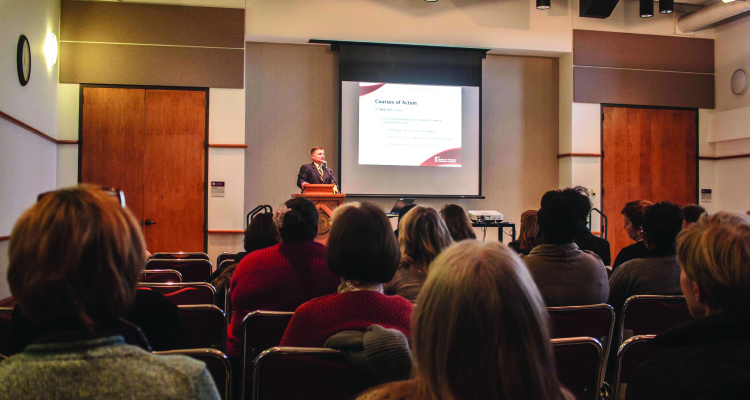BY MATTHEW KONDRAT, NEWS EDITOR
Officer Alan Saylor, a crime prevention specialist from the University of Kentucky, spoke on Jan. 12 about preventing injuries or deaths in an active-shooter event through a training program that emphasizes the actions taken by possible victims to survive the short time until the police arrive.
This training, offered to staff members, faculty and students, emphasized being prepared “in all environments that you could be in, not just a campus environment,” and encouraged trainees to develop a mindset for survival.
“From Sandy Hook to Virginia Tech, all these people survive and there are some things they did that helped them survive,” Saylor said. “And so what we have to do is to come back and teach you those things. And so with that in mind, we’re going to try to give you a survival mindset as the course of action to take today.”
Saylor first defined what an “active shooter” meant, saying that an active shooter is “a person who enters a building with the sole purpose of injuring and killing as many people as they possibly can within a 14 minute stopwatch death.”
Saylor said an active shooter situation typically starts and ends in 14 minutes, based on the national average.
Saylor also focused on the importance of constantly thinking and being prepared.
“We know this happens everywhere. Violence happens everywhere,” Saylor said. “And we know that they are potentially catastrophic every time they do happen. But we have to give you some tools to react.”
Saylor also emphasized the power of thinking clearly and not panicking to ensure safety in an active-shooter situation.
“Are you doing anything for yourself in panic? Can you do anything for yourself in panic? You can’t, there’s no decisions being made. And therefore, you’re a danger to yourself,” Saylor said. “Ask yourself, looking at your environment: Where am I going to go? What am I going to do? Having a pre-determined mindset will help you take rapid and effective decisions.”
Saylor said the bottom line for anyone in this type of situation is to take direct responsibility for their own personal safety.
He advised either fleeing the scene, if possible, or hiding until the police arrive and the dangerous situation has ended.
Saylor emphasized that if an exit is visible, fleeing is preferable to sheltering in place.
Dr. Helen Grace Ryan, Vice President of Student Affairs, estimated 100 people attended the three sessions that offered the training.
Only two students attended the training sessions, which suffered from a lack of publicity. “I heard of it in the Daily Knight the day of, but it had passed by then,” senior Caleb Rohrig said.
The only two students who attended were reporters for The Concord covering the story.
Dr. Martha Mazur, environmental science professor, said the training reassured her. “It provided a critical set of tools to use in the event of an active shooter,” Mazur said.

